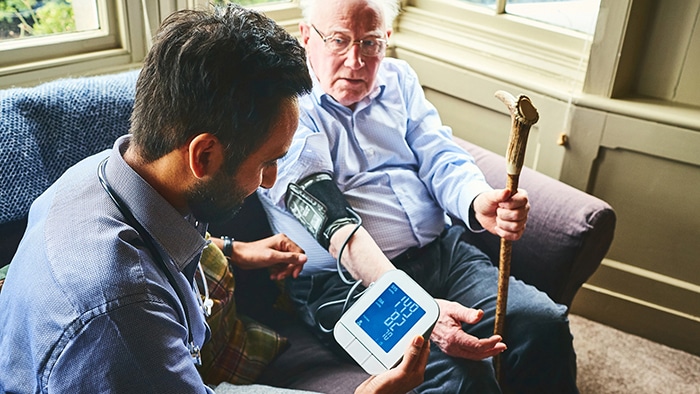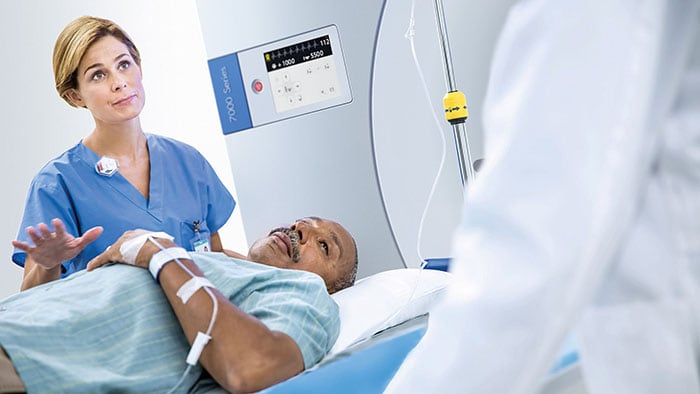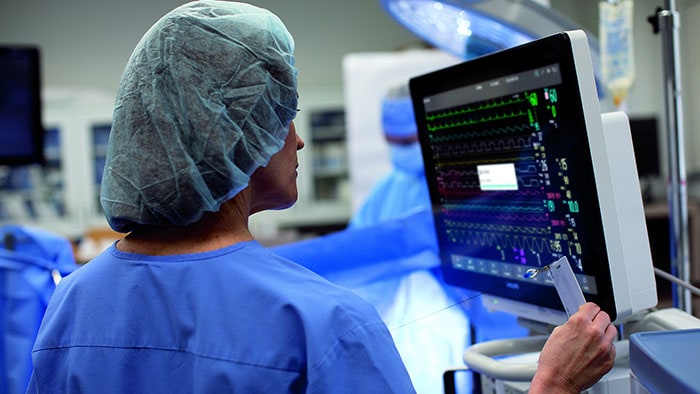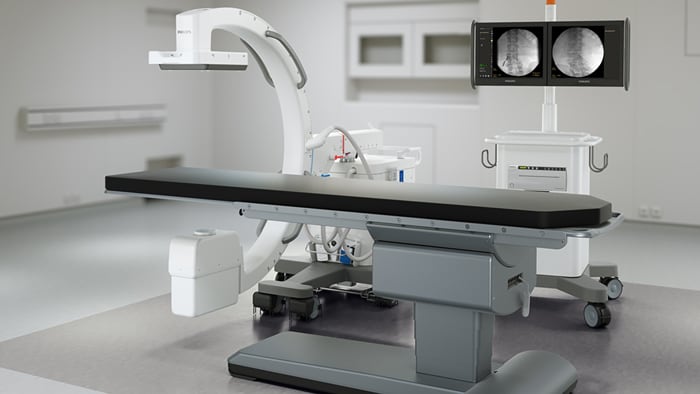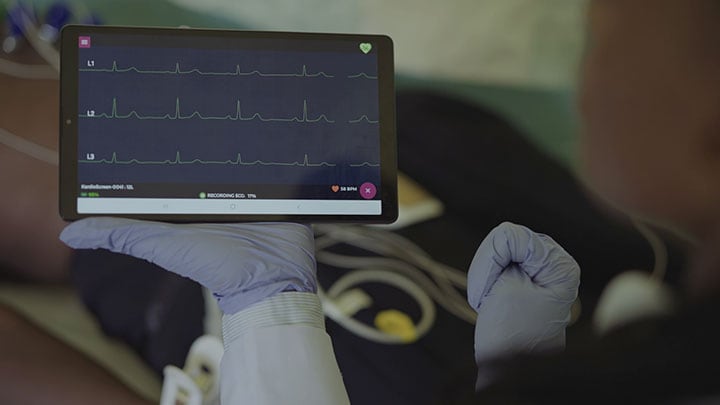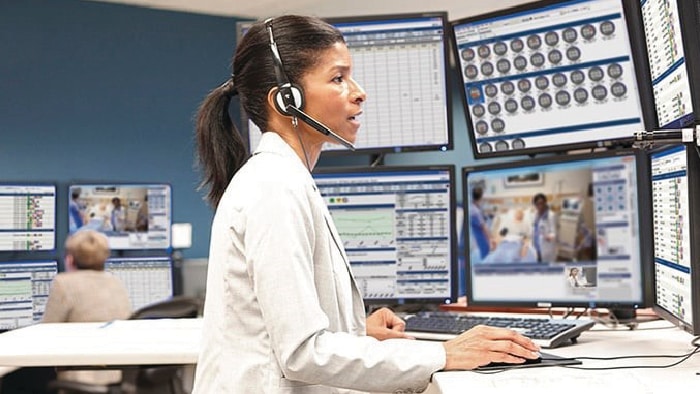The hospital of the future: emerging trends and technologies – Q&A with Dr. Alan Pitt
Aug 01, 2023 - Reading time 4-6 minutes
In a series of articles, we explore the future of healthcare delivery, including the evolving role of hospital care. For this edition, we spoke with Dr. Alan Pitt, neuroradiologist at Barrow Neurological Institute and CEO at Vitalchat, to discuss emerging trends and technologies in radiology – from changing workforce expectations to the rise of generative AI – and what these developments mean for hospitals and healthcare at large.
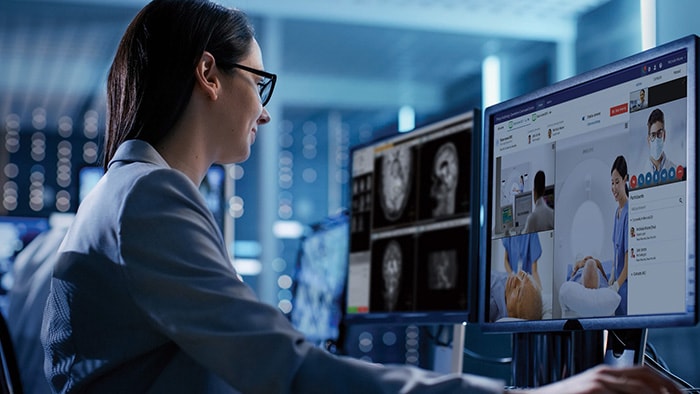
Q: Dr. Pitt, staff shortages are currently the top concern for healthcare leaders worldwide and are only expected to grow. How do you see this manifest in radiology, and how can hospitals continue to attract and retain talent? A: First, I think we have to acknowledge that the hospital worker in a post-pandemic world is not the worker from the pre-pandemic world. While the pandemic put extreme pressure on frontline staff, it also made many of us reflect on the way we do things and on the role that work plays in our lives. Especially younger generations of workers are seeking more flexibility and a better work-life balance. We’re seeing a clear increase in shift workers in radiology – and in healthcare in general – who show up to fill a gap and then move on and leave. They are still committed to the patient, but they may not be as committed to a hospital system anymore. And if I look at the radiology fellows I am training today, many of them are looking for remote jobs because they want to be able to work from anywhere. I was actually an early zealot for teleradiology and telemedicine myself in the early 2000s, because I could see the efficiency it would bring to our practice. What I didn’t appreciate at the time is that there can also be a dark side to remote work, and that’s something we are beginning to see in healthcare today. When radiologists become faceless interpreters in the cloud, there can be a subtle erosion of organizational culture and professionalism, and a lack of attachment to the community. How are you going to build a presence in a hospital department if you are never there? So, I think healthcare is going to have to find a middle ground, much like any other industry that is having to adjust to hybrid work. To attract and retain good people, we need to offer them choice in how they want to engage with work, whether that is in the hospital or remotely. I have always believed that the future of radiology is ‘anytime, anywhere’. That trend is not going to stop. At the same time, we need to think of ways to bring remote workers together again intermittently, for example through dedicated in-person meetings where we build professionalism outside our day-to-day workflow.
“The hospital of the future should reconnect healthcare professionals back to their purpose: caring for patients”
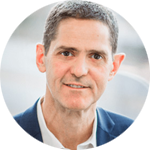
Alan Pitt, MD
Professor of Neuroradiology, Barrow Neurological Institute and CEO, Vitalchat
Q: You are a staunch advocate of reconnecting healthcare workers back to their purpose. Could you explain what you mean by that? A: Absolutely. I think that if you’re going to expect people to feel truly engaged in your hospital system, they need to feel a strong sense of purpose. But what we’ve seen in healthcare over the past few decades is a constant drumbeat of additional administration and regulation, which is actually pulling healthcare workers away from their purpose. We’ve kept adding ‘one more thing’, without asking how it fits into their overall workflow and experience. As a result, we now spend more time documenting than caring for patients. No one loves being a scribe to the electronic medical record (EMR). That’s why I think it is incredibly important that we reconnect healthcare workers back to their purpose. That means thinking people before technology – really asking what it means for a healthcare professional to interact with a certain technology, and how it can support their workflow. It also means we need to find better ways of tracking and highlighting the value that healthcare workers deliver to the patient. Right now, healthcare can often feel quite transactional. We all do our little part in caring for a patient, but it’s quite rare that we hear back how our efforts ultimately benefited the patient. As radiologists, we have also been hesitant to build relationships with patients because our primary focus has always been on the relationship with the referring physician. Simple technologies such as automated texting could help gather feedback from patients over time. Did that one CT scan make a positive difference in a patient’s life? Are they now feeling less pain after getting their diagnosis and treatment? We need to follow the patient forward to see the impact of an imaging study on a patient’s journey towards wellness. That’s what gives me purpose as a physician, and that’s what helps me understand if my work provided value to a patient or not. As we have less and less money to spend in healthcare, I expect value-based imaging to become an economic necessity, too. Healthcare systems will no longer be able to afford redundant or unnecessary imaging.
Q: You previously touched on the role of teleradiology and telemedicine. How can they help mitigate staff shortages and how do you see them shaping the future of hospital care more broadly? A: As experienced workers in healthcare are becoming harder to find, we need to figure out how we can put expertise in the hands of less experienced workers to help them make decisions. Virtualization is an enabler of this, because it creates new opportunities for mentorship and education across all experience levels in a hospital system. For example, you could have an experienced neuroradiologist in Phoenix supporting a general radiologist in a smaller satellite location, or you could have an experienced technologist remotely guiding image acquisition by a less experienced peer. All in real time. More generally, I like to think of it as a ‘healthcare pyramid’, where you have healthcare workers with varying levels of training and education. The person with the most experience in a certain field should only be drawn in when necessary, and that person should empower everyone who has less experience. It may sound obvious because that’s how most industries operate, but in healthcare we tend not to organize ourselves that way. In a large business, you would never ask a CEO to solve a problem from start to finish – you would have others summarize relevant information for them, and then ask the CEO for an opinion or decision. But in healthcare, it’s actually still quite common for a specialist to do a full intake on a patient, even when less experienced colleagues could do part of that work. So, I think the bigger message here is that we need to start using scarce resources more judiciously in healthcare. It’s really about empowering every healthcare worker to operate at the top of their license, by making the right expertise available to the right person at the right time – and to do that at scale using new technologies.

Q: Speaking of how technology can empower healthcare professionals, how do you see the impact of generative AI on radiology and on healthcare in general? A: I think its impact is going to be huge; there is going to be a pre- and post-generative-AI world in healthcare. One of the biggest opportunities I see is to bring various sources of patient information together in a meaningful way, to paint a more complete picture of that patient – which is something we have always struggled with in radiology because of how fragmented healthcare is. Today, we tend to look at diagnostic imaging in a silo. The vast majority of imaging systems sits in its own realm, disconnected from the EMR, lab results, and other patient data. As a radiologist I can tell you what I see in a MR or CT scan, but the more I know about the patient, the better I’ll understand what I’m looking at, and the more value I will be able to provide. That’s where generative AI can support me, by pulling different information sources together, and then generating a list of potential diagnoses and corresponding probabilities for a particular imaging study. UItimately this will pave the way towards what I like to call ‘ambient intelligence’, where I sit down at my radiology workstation and have access to every bit of information I need at my fingertips. Not only that, but a virtual assistant will also provide me with relevant insights and recommendations. It may say to me: “Dr. Pitt, I have taken a preliminary look at this patient’s images, I’ve also consumed information from the EMR, lab results and other sources, and I’ve found a similar patient who is also 73 years old, with diabetes and heart disease. Based on my analysis I expect to see these and these comorbidities, and this is something I suggest you pay close attention to.” So you’re going to see increasingly intelligent support systems, but the radiologist will remain in control and accountable, much like the pilot of a plane.
Q: How do you expect to see the role of physicians evolve as a result? A: First, I think it’s important to realize that automation almost never replaces people. It changes people. Everyone is going to have to figure out: what’s my new job? As physicians we used to be oracles of knowledge. But in the era of AI and instant access to knowledge, my job is no longer just to possess and recall vast amounts of medical knowledge. It is to use that knowledge in a way that positively impacts my patients. That means we need to be able to truly understand our patients, communicate effectively with other healthcare providers, and work together as a team to provide the best possible care. Our ability to read a patient’s body language, their concerns, and the subtext of what they are saying – these human skills will become even more important. Medical schools should adapt their training programs accordingly, so that future care providers are equipped to be the best possible partners in healing and treating disease. Traditionally, we have rewarded physicians for IQ rather than emotional intelligence (EQ). But in an AI-enabled future, their EQ will actually become more important than their IQ. By rethinking the traditional approach to medicine and medical education with the latest technologies, we can create a healthcare system that truly puts patients first. This conversation was edited for flow and clarity.
